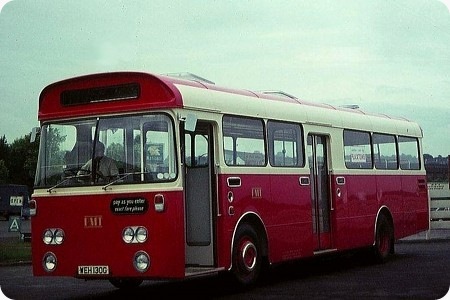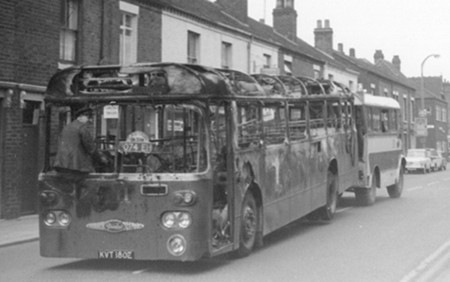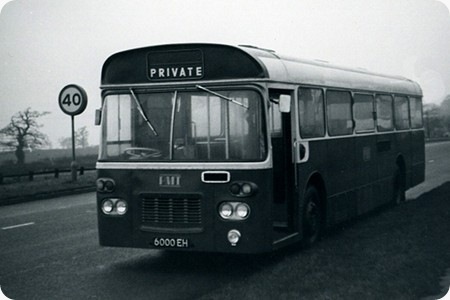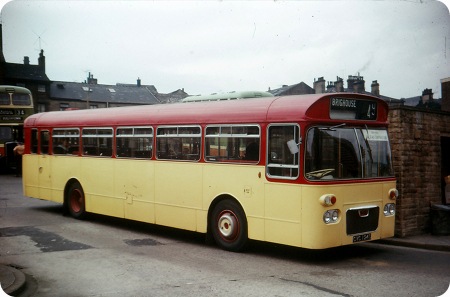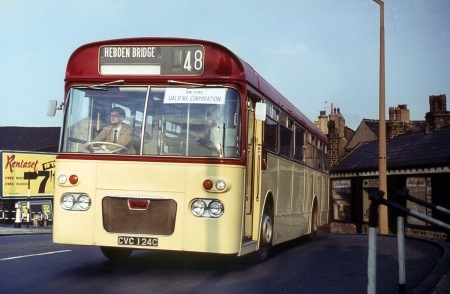PMT – Daimler Roadliner SRP8 – WEH 130G – 130
Potteries Motor Traction
1969
Daimler Roadliner SRP8
Plaxton B46D
130 was the first of the final batch of ten Roadliners (130-139) to be delivered to PMT. They had Plaxton bodies to their standard timber framed design with BET style front and rear screens. Apart from the Perkins V8.510 engine, they were similar mechanically to the previous deliveries although they had the miniature Westinghouse air gear shift with a sixth position to operate the centre doors. The Perkins engine was a vast improvement on the Cummins V6 but did suffer from premature cylinder bore wear causing high oil consumption possibly due to some inadequacy in the air filtration system.
The bodies were built with a higher floor level requiring an entrance step (earlier buses had a step free entrance). They were built to the dual door layout then briefly in vogue. Heated windscreens were an innovation on these buses controlled by a wind up clockwork timer(!!) which quickly proved unsuitable for heavy duty bus operation. Some early deliveries went to Stafford Garage and I recall a report from the Inspector there about the indelicacy of young mini skirted mothers when retrieving their push chairs from the luggage pen which had rather a high rail round it!! 130 was the only one in the batch to have the once standard cream panel above the saloon windows, 131 onwards had all red roofs. These were also the first new buses not to have the familiar prefix letters to the fleet number (following on from SN1129 which was the last of the short Marshall bodied Leopards delivered the previous year). The above photo was taken on 1st July 1969 shortly after delivery at the weighbridge at Shelton Iron and Steel where we took the first of each batch of new buses for weighing. The driver is Bill Davies who was a Management Trainee at the time.
This is a shot of an earlier Roadliner KVT 180E fleet number S1080 being towed into Stoke Central Works shortly after being burnt out at Swynnerton on 25th March 1969 it was rebodied with an identical body to the 130-139 batch returning to service on 1st August 1969.
PMT cancelled a further order for Roadliners and substituted single deck Fleetlines but date wise they are outside the time period of this website.
Photographs and Copy contributed by Ian Wild
10/03/11 – 07:48
I was the first driver to go into service with 138, it was a Saturday afternoon I was based at Newcastle garage and both 138 and 139 were put on the Burslem Silverdale service on the shift change over. I don’t remember driving anything so fast and it was a struggle not to run early on this service, going up hills was not a problem at all with these vehicles it was "just like driving a mail train as they say"
Michael Crofts
28/07/11 – 15:27
Funny you should mention 138; I’m sure that was the one I saw at Preston North End’s Deepdale ground in the late 1970s having gone there to watch Port Vale play. Only the driver of our Bostock’s coach, who was as big a bus nut as I was, and myself made any comment. It had been sold by PMT to a local independent.
Mel Harwood
22/05/12 – 07:54
I would imagine that it was 137 you saw in Preston as it was latterly owned by Holmeswood Coaches of Rufford … coincidentally the present owners of Bostocks.
Martyn Hearson
10/05/17 – 07:18
I remember Roadliners that West Riding operated, on a trip from Horbury to Flockton on the Wakefield Huddersfield service I think the service number was 89 or 86 this particular Saturday was entering Flockton the Netherton Midgley side and there is a sharp left hand bend just as we approached the bend round the corner came lorry cutting the corner on our side of the road the driver could only put the bus as near to wall and trees on our side of the road as he could and hope that we missed each other which we did ,from the front of the bus came a substantial number of choice Yorkshire adjectives expressing the doubt that our West Riding had of the driver of the lorrys parentage and when we got to Flockton the driver removed the assorted foliage from front nearside wingmirror mounting and doors and nearside open windows, as we got off in Flockton our driver said to my mum are you an lad or rite lass, mum said yes the driver said aye lass that were close at least I haven’t scratched it they only got this b***** yesterday!
David Parkin
03/03/20 – 06:53
From a laymans point of view and having travelled many times on these buses I always thought they offered a much better ride than the previously delivered Roadliners. Travelling on the early batches of Roadliners was much more of a bouncy ride, so was there a change to the suspension on the last batch?
Leekensian
12/03/20 – 06:05
No, the final batch had Metalastik Toggle Link suspension units the same as the previous Roadliners. Thinking about it, I recall a better ride-maybe different rated shock absorbers?
Ian Wild
18/03/20 – 06:49
I recall that two of the original batches of Roadliners were converted to Perkins engines – S1065 & S1078 spring to mind, but did not prevent their early withdrawal along with the majority of the Roadliners.
Leekensian
Quick links to the - Comments Page - Contact Page - Home Page
